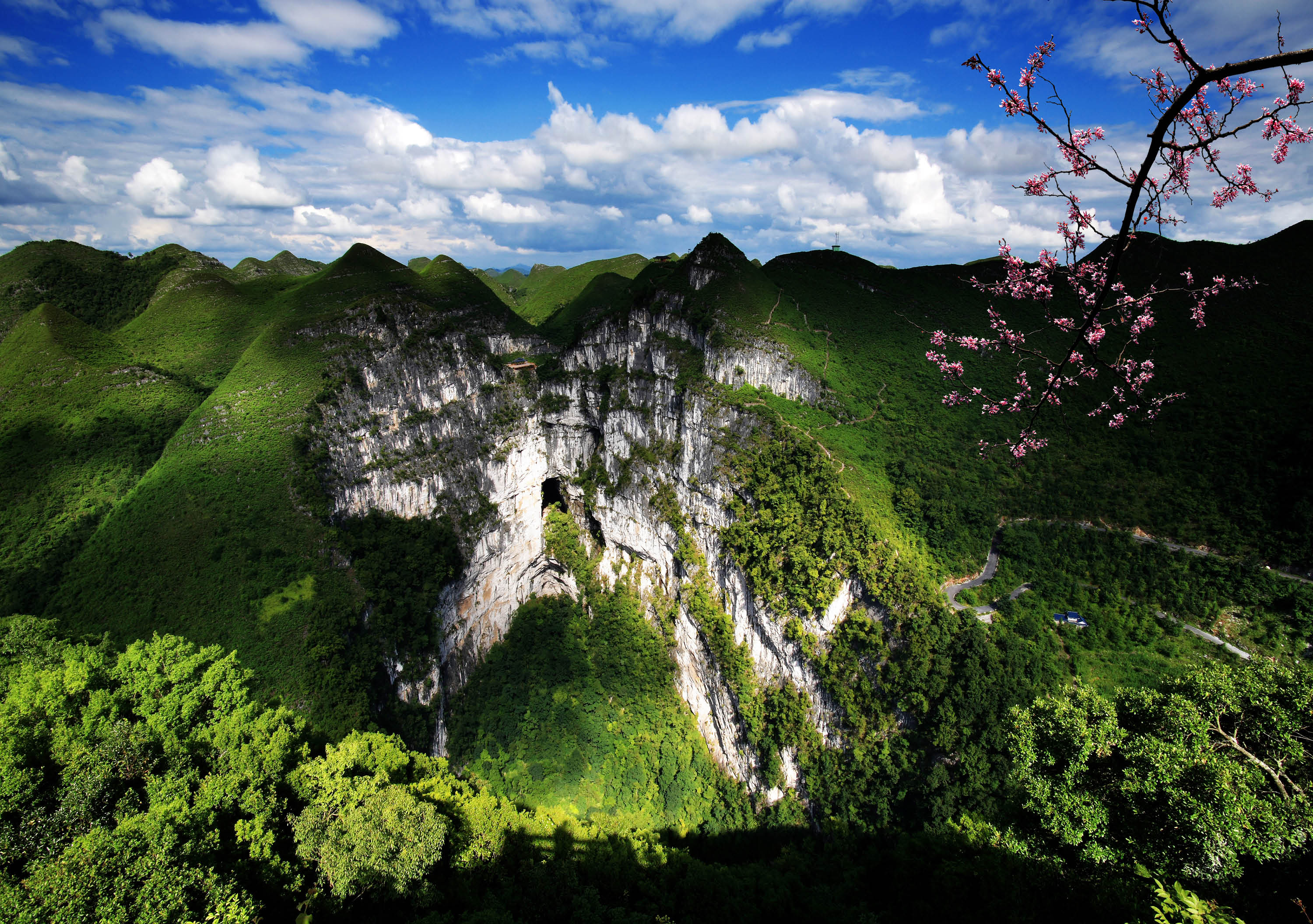Baise City: In the Fast Lane of Scientific Development
By XU YING
 |
| The Dashiwei Tiankeng. There are two dozen such karst dolines in Baise. |
BAISE (pronounced Bye-sir as in British English) City in Guangxi Zhuang Autonomous Region was a revolutionary stronghold in the years of conflict prior to the founding of the People’s Republic of China. Like other bastions of the revolution, Baise, a frontier town bordering Vietnam, was relatively poor and underdeveloped.
The economy of Baise developed in leaps and bounds in the past decade. In November 2002 Baise Prefecture was promoted to city status, heralding 10 years of supercharged growth for the southern dynamo.
In the past decade the city has seen remarkable progress in many aspects of its economic and societal development. Its rich natural resources – ranging from aluminum, coal and water to fertile land – and wealth of tourist attractions have enabled Baise to reinvent itself from an agrarian community to an emerging industrial base. Throughout this reinvention, the wellbeing of locals has been stressed, and their standard of living has improved markedly.
In light of the changing times and new economic and social realities, the city has been constantly calibrating its strategies and goals for development. Today, these goals can be summarized as: to work for a prosperous, happy, eco-friendly, charming and harmonious Baise.
The authorities in Baise have reasons to be optimistic. Hard facts support local ambition. In the past decade the city’s GDP grew at an annual rate of 13.9 percent. It stood at RMB 66.41 billion in 2011, 3.8 times that of 2002. The gross output value of industrial enterprises with annual business revenue of RMB 5 million or more soared from RMB 6.725 billion in 2002 to RMB 69.48 billion in 2011, a 10.3 fold rise. Over the same period its fiscal revenue rose five-fold and investment in fixed assets 12.1-fold. Other economic indexes also witnessed two-digit gains.
Agricultural Strength
Enjoying a balmy subtropical climate, Baise is gifted with a wealth of agricultural resources. It is traditionally strong in subtropical fruit, characteristic livestock and aquatic products, vegetables and tea, tobacco and sugar production.
Baise is the largest producer of tobacco and tea in Guangxi, and also a top-ranking supplier of mongo (a sweet yellowish fruit) nationwide. Baise’s Xilin County enjoys a national reputation for its sweet tangerine. Leye County is at the forefront of organic farming in China. Zhongping Village in Tiandong County is known for its shallots, and Langfu Village in Lingyun County produces Baihao (Pekoe) Tea, a popular brand in tea-obsessed China.
With the application of modern technologies and machinery, local agricultural productivity has shot up, bringing substantial benefits to rural residents. In 2011 the output value of the farming, fishery, forestry and animal husbandry sectors exceeded RMB 20 billion for the first time. Valued at RMB 20.29 billion, output was 2.55 times that for the year 2002. In 2011 Baise’s average per capita disposable income for urban dwellers climbed to RMB 17,384, and farmer’s net income reached RMB 4,052 per capita.
Entrepreneurship and innovative spirit is blossoming among local farmers. There are now 41 highly industrialized rural enterprises and 696 farmers’ cooperatives in Baise. The rural financial reform in Tiandong County is among the boldest reform agendas in China. It offers many lessons and experiences from which other regions of the country can learn. For instance, the “China Resources Hope Town” has been a great example of combining resources from government, business and local communities to improve lives in the countryside.
Building Socialist New Countryside
Baise has been waging a massive campaign to build and upgrade its infrastructure since 2002. In that time, local housing and transport conditions improved beyond recognition. The city was honored for its efforts when in 2011 it was named a “National Garden City.”
Over the years Baise has built its first expressways and civil airport. To date three expressways have been completed, and five more are under construction. Four air routes have been opened, linking Baise with Guangzhou, Chongqing, Guilin and Kunming.
Smarter infrastructure, a more beautiful cityscape and better transport connections have wooed organizers of regional, national and international exhibitions and trade fairs. Baise has so far hosted five installations of the China-ASEAN Modern Agricultural Exhibition and Trade Fair. The event has greatly boosted the city’s regional and international presence and reputation as a city open for business.
In the past decade Baise has launched over 1,500 projects with a total investment value of RMB 10 million or more. Projects cover industries such as aluminum production, new energy, biopharmacy, commerce, logistics and tourism. Total industrial investment has amounted to RMB 193 billion. Never before have such funds been invested in Baise in so short a time span. The establishment of national Category-One Longbang and Pingmeng ports has given a further boost to the local economy.
A key feature of Baise’s recent economic successes has been strong growth in the local private sector. Baise was home to 726 private businesses in 2002; by 2011, the number jumped to 6,877. The city has also carved out a niche for itself in tourism. Home to a UNESCO Geopark and eight national AAAA tourist attractions, Baise is regarded by many as one of southern China’s top tourist destinations.
Better Social Services
With respect to social undertakings, Baise is committed to ensuring equal access to public services for all citizens and providing them with a higher quality of life. Headway is made tackling poverty and halting environmental degradation. The new old-age insurance for rural residents and basic medical insurance for city dwellers covered the whole population earlier than scheduled. And almost all those who qualify are receiving the basic subsistence allowance.
Subsidized housing projects are rolled out in both urban and rural areas. Housing options include renovated cottages, rent-controlled apartments and low-income homes. In the fight against rural poverty, new infrastructure has been built, new sources of income explored and settlements in inhospitable or inaccessible regions relocated with the consent of the local population.
The results are apparent in numbers. In the past decade Baise’s population living below the poverty line shrank by 849,000. So many people getting rid of poverty in a decade is a great achievement.
All local children now have access to nine-year compulsory education. A nutrition program has been introduced into rural primary and junior middle schools. Seven items have been added to the list of national intangible cultural heritage, ensuring national funds for their protection. In 2010 the World Brand Organization, the U.S.-China Economic, Trade & Investment General Chamber of Commerce and Europe-America-Asia Cooperation Union for Investment in Industry and Commerce (EAACU) nominated Baise as one of China’s most charming cities.
Innovative and Honest Government
Baise was the first city in Guangxi to set up outreach centers in villages to provide on-site services, survey opinions directly from the people and handle grassroots-level issues as they arise. It is also among the first in the autonomous region to establish a municipal legal service center and require every town and township to have a legal affairs commission. These measures have paid off. In 2011 Baise ranked fourth in Guangxi on all six indexes for public security and social stability. Baise’s advanced grassroots leaders were subsequently invited to several regional and national meetings to present lessons from their experience in social administration.
The Publicity Department of the CPC Central Committee has recommended that local authorities nationwide learn from their innovations in rural work. The measures, such as ensuring transparency in the appointment and promotion of town and township officials, and placing up-and-coming college graduates in official village posts, also won accolades from regional and national leaders. Baise’s experience in building “clean government” has been highlighted in several regional and national meetings. The Baise Uprising Museum has also been named by the CPC Central Commission for Discipline Inspection as a base for moral education of public servants. It is the only such base in Guangxi.
Since the turn of the millennium, Baise has made rapid progress on all fronts. The city is steadily moving toward its 2015 goals of doubling its 2010 GDP, fiscal revenue, investment in fixed assets, retail sales of consumer goods, import and export volumes and income from tourism. Baise also plans to quadruple its industrial output based on 2010 levels, and elevate major social and economic indexes to be on par with moderately prosperous regions of China's western provinces.

